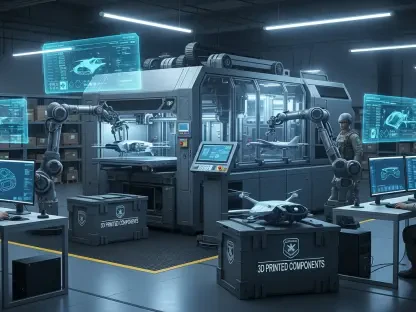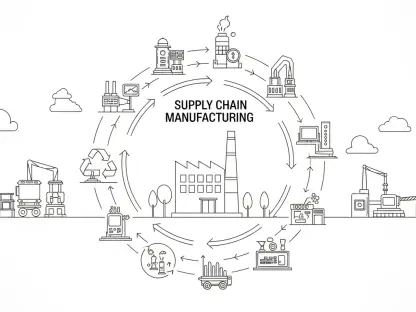Global supply chains have been scrutinized intensely since the disruptions caused by the COVID-19 pandemic in 2020. The pandemic, evolving cybersecurity threats, and heightened global competition have brought supply chain vulnerabilities to the forefront of national security discussions. This article explores the trends and challenges in modern supply chain management, particularly as it pertains to national security, as well as the responses and opportunities identified by The Chertoff Group, a leading consultancy in security and risk management.
Key Supply Chain Threats
Security Concerns
Chad Sweet, CEO and Co-Founder of The Chertoff Group, along with Michele Iversen, the firm’s newly appointed principal and head of geopolitical and regulatory risk, discuss the pressing supply chain threats facing the United States. Sweet identifies three main components that drive supply chain security concerns. The first is security, which involves protecting supply chains from vulnerabilities, particularly in the defense industrial base and critical infrastructure. Preventing adversaries from exploiting hardware, software, or other inputs for espionage or pre-conflict reconnaissance is crucial. Additionally, it’s essential to avoid relying on adversarial countries for critical supplies and technologies.
Considering the complexities of modern technology and the global integration of supply chains, ensuring security goes beyond traditional measures. It requires a comprehensive understanding of the potential threats and vulnerabilities within the supply chain at all levels. Organizations need to adopt advanced threat detection capabilities and invest in robust cybersecurity measures. With adversaries continuously evolving their tactics, staying ahead means constantly assessing vulnerabilities and developing new countermeasures to safeguard essential supplies and technologies.
Building Resiliency
The second component is resiliency. Building resilience to withstand disruptions, whether they are natural disasters or man-made events, is vital. Government contractors must consider the impacts of tariffs, retaliatory actions, and other geopolitical shifts on their supply chains. Properly assessing and inventorying alternative sources of critical inputs can provide a competitive advantage. This proactive approach ensures that supply chains can adapt and recover quickly from unforeseen disruptions.
A resilient supply chain is not just a defensive mechanism but a strategic asset. It involves diversifying suppliers, incorporating flexible logistical options, and maintaining a thorough understanding of the supply chain’s dependencies. By implementing comprehensive risk assessments and scenario planning, organizations can better prepare for a range of potential disruptions. This preparation includes understanding how different events might impact the supply chain and having the necessary resources and processes in place to mitigate these effects swiftly. Such measures promote rapid recovery and sustained operations, crucial in maintaining competitiveness and fulfilling contractual obligations.
Industrial Policy Goals
The third component involves industrial policy goals. Recent legislation focuses on increasing domestic content and production. Government contractors must ensure compliance with policies like the “Buy American, Build American” (BABA) requirements to stay competitive and align with regulatory standards. This shift towards domestic production aims to reduce dependency on foreign suppliers and enhance national security.
This legislative push requires rethinking traditional supply chain strategies. Organizations need to reassess their procurement procedures, align with new compliance standards, and potentially invest in domestic production capabilities. It also means fostering local partnerships and building relationships with domestic suppliers to ensure a steady flow of critical materials. By doing so, organizations not only comply with new regulations but also build supply chains that are more resilient and less vulnerable to global disruptions. Making these adjustments represents an opportunity to innovate and strategically position themselves for long-term resilience and market competitiveness.
Trends and Opportunities
Strategic Importance of Supply Chain Management
Sweet emphasizes the shift from viewing supply chain management as a cost center to recognizing its strategic importance. A proactive approach is advocated, one that goes beyond mere resilience. Nassim Taleb’s concept of “anti-fragility” is introduced, which involves preparing for disruptions and aiming to restore operations faster than competitors. This approach allows organizations to gain a competitive edge, especially in the government contracting space where reliable service delivery is critical.
This shift requires a fundamental change in how supply chain management is perceived and implemented. Instead of minimizing costs at the expense of robustness, the focus shifts to creating systems that improve and learn from disruptions. By integrating anti-fragility into supply chain strategies, organizations can develop methodologies that not only protect against unforeseen events but also capitalize on them. This strategic shift involves continual learning, optimization, and adaptation, transforming supply chain resiliency into a dynamic competitive advantage. Government contractors, in particular, must adopt these strategies to ensure the uninterrupted delivery of services and to maintain their standing in the market.
Geographic Concentration Risks
The COVID-19 pandemic exposed the risks of geographic concentration in supply chains, particularly the reliance on a single country like China. This has led to a shift from a “just-in-time” supply chain model to a “just-in-case” approach, emphasizing the importance of building redundancy and resilience. Additionally, there is a push for reshoring or nearshoring critical supply chains to the United States or friendly countries to reduce reliance on adversarial nations.
Shifting to a “just-in-case” model involves creating buffer stocks and diversifying supplier bases to mitigate the impact of supply disruptions. Reshoring and nearshoring initiatives not only aim to mitigate risks but also to foster innovation and economic growth domestically. By reinforcing local supply chains, organizations can reduce lead times, improve quality control, and enhance their ability to cope with international disruptions. This strategic shift also aligns with broader economic and security policies, which seek to bolster domestic capabilities and reduce vulnerabilities that arise from over-dependence on single-source countries.
Changes in Supply Chain Security
Efficiency in Travel Supply Chains
The Chertoff Group is exploring various opportunities to expand its portfolio. One such opportunity is improving efficiency in travel supply chains. Partnering with companies like SureScan and Xcelerate, they are developing solutions like Gigaplex, which helps TSA manage costs and improve efficiency by securely transmitting scanned images to regional hubs. This reduces false positives and enhances response times to emerging threats.
Improving efficiency within travel supply chains involves implementing advanced technologies and process innovations to streamline operations. For agencies like the TSA, integrating solutions such as Gigaplex means enhancing their capability to analyze and respond to potential threats swiftly and accurately. This not only improves security but also operational efficiency by minimizing delays and false alarms. By leveraging high-tech scanning and data transmission technologies, the TSA can manage immense volumes of data more efficiently, allocate resources more effectively, and ensure a faster response to genuine security threats. Such enhancements are critical in improving overall transportation security and efficiency.
Maritime Surveillance
Another area of focus is maritime surveillance. ThayerMahan’s deployment of autonomous unmanned underwater vehicles for long-term maritime surveillance offers a cost-effective alternative to traditional methods, augmenting the capabilities of the submarine fleet. This innovative approach enhances the security and monitoring of maritime activities, providing a strategic advantage.
The use of autonomous unmanned underwater vehicles signifies a significant advancement in maritime surveillance capabilities. These vehicles operate for extended durations, gathering critical data and monitoring marine environments with enhanced precision and lower operational costs. By incorporating advanced sensors and AI-driven analysis, they can detect anomalies and potential threats more efficiently than traditional methods. This strategic deployment enhances situational awareness and security in maritime zones, offering a cost-efficient solution to augment existing naval operations. It highlights a broader trend towards embracing automation and AI technologies to bolster national security infrastructure.
Product Assurance
The Chertoff Group is also partnering with Exiger, a supply chain illumination company, to develop a product assurance playbook. This involves identifying critical products, analyzing supply chain risks, and implementing continuous monitoring programs to ensure reliability and compliance with evolving regulations. This proactive strategy helps organizations maintain the integrity and security of their supply chains.
Ensuring product assurance involves a detailed analysis of the entire supply chain from raw materials to final products. By employing advanced risk assessment tools and continuous monitoring, organizations can detect and mitigate potential threats to product integrity and security in real-time. This method not only safeguards against quality issues and compliance violations but also strengthens overall supply chain reliability. Developing a robust product assurance framework requires a combination of technological innovation, rigorous standards, and ongoing vigilance. Such comprehensive measures ensure that critical products maintain their integrity and compliance throughout the supply chain lifecycle.
Federal Strategy
Supporting Government Contractors
The Chertoff Group’s federal strategy focuses on helping government contractors grow and secure their operations. This involves tracking policy developments, preparing scenarios in alignment with administration priorities, and strategizing around issues such as tariffs and energy independence. Initiatives like Gigaplex for the TSA and ThayerMahan’s maritime surveillance solutions are examples of how the firm is driving efficiency and security in government operations.
Supporting government contractors goes beyond merely ensuring compliance and security; it involves fostering an environment of innovation and strategic growth. By keeping abreast of policy developments and anticipating regulatory changes, The Chertoff Group aids contractors in navigating complex and evolving landscapes. This proactive strategy ensures that government contractors are well-equipped to adapt to new conditions, align with public sector priorities, and harness opportunities emerging from regulatory shifts. These efforts help fortify government operations and enhance national security, reflecting a robust federal strategy dedicated to comprehensive support.
Aligning with Administration Priorities
By aligning with administration priorities, The Chertoff Group ensures that government contractors are well-prepared to navigate the complex regulatory landscape. This includes staying informed about policy changes and adapting strategies to meet new requirements. This proactive approach helps contractors remain competitive and compliant in an ever-evolving environment.
Understanding and integrating administration priorities into operational strategies is key to maintaining compliance and achieving organizational objectives. The Chertoff Group’s approach involves continuous monitoring of regulatory updates and a deep understanding of policy implications. This alignment ensures that government contractors can anticipate and swiftly respond to shifts in policy, thereby maintaining a competitive edge. It also involves strategic planning and scenario analysis to prepare for various regulatory outcomes. By fostering this alignment, The Chertoff Group not only supports compliance but also drives strategic growth and resilience in the face of regulatory challenges.
Conclusion
Since the COVID-19 pandemic disrupted global supply chains in 2020, these networks have been under intense scrutiny. The pandemic revealed significant vulnerabilities, impacting everything from manufacturing to the delivery of goods worldwide. Additionally, the rise in cybersecurity threats and increased global competition has further highlighted these weaknesses. Today, supply chain security is a vital aspect of national security discussions.
This article delves into the current trends and challenges facing modern supply chain management, with a particular focus on national security implications. Companies and governments alike are now prioritizing the resilience and security of their supply chains to avoid future disruptions.
The Chertoff Group, a leading consultancy specializing in security and risk management, has identified several responses and opportunities in this sector. Their insights are crucial in understanding how we can bolster supply chain security. By addressing these vulnerabilities, we can not only prevent potential crises but also seize opportunities to improve efficiency and reliability in the long term.









